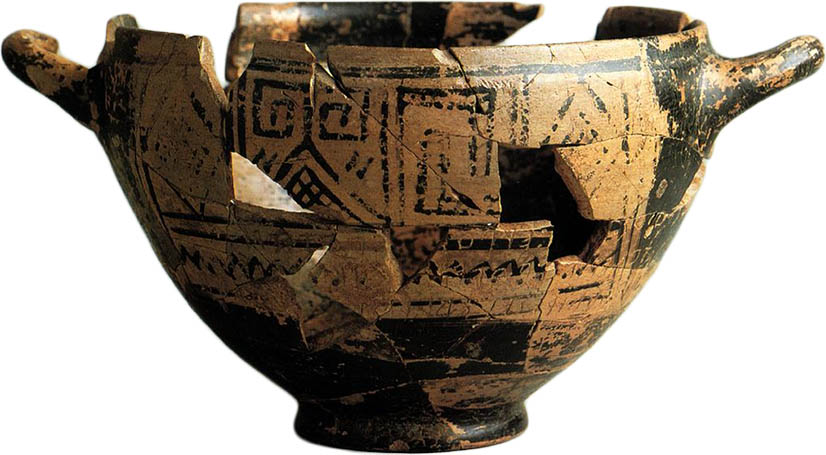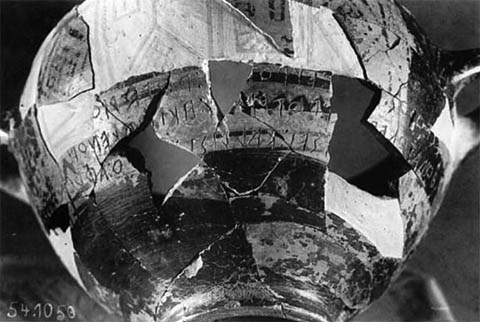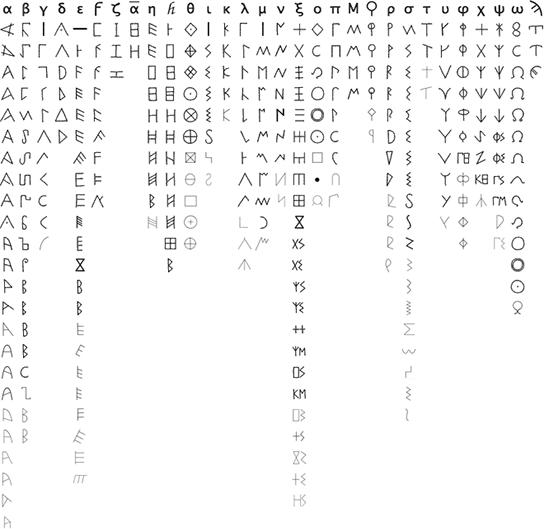
13
Nestor’s Cup
The Greek Alphabet
Nestor’s Cup, or Coppa di Nestore, is a ceramic kotyle, or, more specifically, the fragments of a kotyle that were discovered in a the grave of a 10-year old boy at Pithekoussai, Ischia, Italy in 1954. The pottery is from the late geometric period (ca. 750 BC) and possibly from Ialysos on Rhodes. A three-line Euboian inscription was later (ca. 720 BC) carved in it’s side and represents one of the earliest known examples of Greek:


The inscription, partially written in hexameter verse, translates roughly to: “I am Nestor’s cup, good to drink from. Whoever drinks this cup empty, straightaway Desire for beautiful-crowned Aphrodite will seize him.” Scholars have many interpretations of the verse, including references to the Iliad, but it may simply state the age-old truism that the more you drink, the hornier you get. As valid today as it apparently was three millennia ago.
The first Greeks to write were the Minoans, perhaps as early as 1900 BC. They used a hieroglyphic-like, and largely undeciphered, script called Linear A. Sometime around 1400 BC the Minoans were conquered by the Mycenaeans, who adopted the script and modified it into Linear B. Linear B appears to have been used strictly for administrative purposes, possibly by scribes serving the royal palaces. The Mycenaeans, in turn, were defeated by the Dorians, or the mysterious Sea Peoples around 1100 BC. Under the Dorian (or Sea People) rule all vestiges of Mycenaen culture were lost, including writing, and for the next several centuries the Greeks entered a Dark Age.
As legend has it, writing again appeared in Greece through Cadmus: Phoenician prince, dragon-slayer, founder of Thebes, son of Agenor and brother of Phoenix, Cilix and Europa. According to Herodotus, again from his Histories (V 58), Cadmus introduced Phoenician, phoinikeia grammata (φοινικήια γράμματα, Phoenician letters), to the Greeks. Exactly when (or how) this occurred is the subject of some debate, but by 750 BC there were numerous examples of this Phoenician derived Greek alphabet.
Greek, however, is a very different from Semitic Phoenician, so the Greeks used some of the unused Phoenician letters as vowels (the Phoenician aleph became the Greek alpha, e.g.), and created the first true alphabet. The script rapidly spread throughout the Greek city-states, with each different region developing their own version of the letters based on their particular dialect.1 To further complicate matters the direction of writing changed several times. Initially it was right-to left, like Phoenician, then changed to boustrophedon (βουστροφηδόν "ox-turning"), where each line, and the letters themselves, were written in alternating directions,2 and, finally, around the fifth century BC, from left to right.

Greek epichoric variants, from ref. 3
These variations are what makes modern day Greek epigraphy so much fun, but it posed significant problems to the ancient Greeks. In 402 BC, the Athenian government decreed that the eastern Ionic alphabet would become the standard throughout Greece.4 This alphabet, with the later addition of accents and diacritics (beginning around 200 BC), has become modern-day 24-letter Greek alphabet.
The influence of Greek on European writing can hardly be over exaggerated. It was the parent of Armenian, Coptic, Cyrillic, Etruscan, Glagolitic and Gothic.
1. German classical scholar and epigraphist Adolf Kirchhoff classified these Epichoric alphabets into three basic types: green (Cretan), red (Western) and blue (Ionic, Attic and Corinthian), see: Kirchoff, Adolf. Studien zur Geschichte des Griechischen Alphabets. Berlin: Ferd. Dümmler's Verlags-Buchhandlung, 1887.
2. To get an idea, old dot-matrix printers print lines (but fortunately, not the letters) boustrophedonically. (and this, obviously, is the word of the day)
3. Adapted from Poinkastas, the excellent online database of Oxford Greek scholar Lillian (Anne) Jeffery’s handwritten notes and other materials associated with her classic The Local Scripts of Archaic Greece (London: Oxford University Press. 1961).
4. Ionic was likely chosen because Homer’s Iliás (Ἰλιάς, Iliad) and Odússeia (Ὀδύσσεια, Odyssey) were originally written in Ionic Greek.
14 Jan 2009, updated 27 Dec 2011 ‧ Typographia Historia